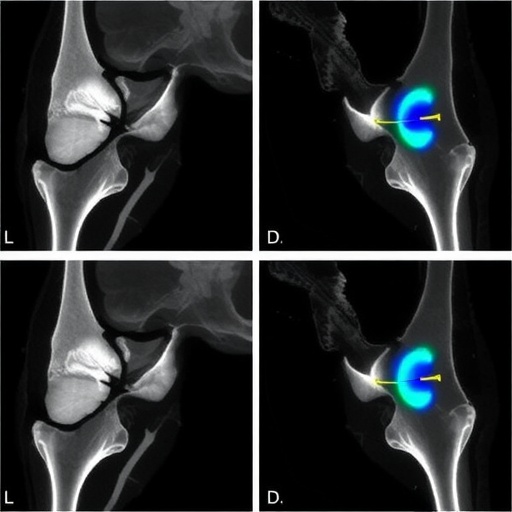
In recent developments within the pediatric medical community, researchers have identified a notable correlation between respiratory infections and episodes of alveolar hemorrhage in children, particularly those affected by diffuse alveolar hemorrhage (DAH). This groundbreaking study, conducted by Wei and colleagues, has brought to light significant implications for understanding the complex interplay between viral infections and pulmonary health in the pediatric population. The ramifications of these findings could potentially shift clinical practices and influence therapeutic approaches towards respiratory infections in vulnerable children.
The retrospective study, situated in a single-center environment, meticulously analyzed clinical data from pediatric patients diagnosed with diffuse alveolar hemorrhage. Traditionally, DAH has been a condition that prompted concerns regarding the underlying etiologies, often linked to a host of factors ranging from autoimmune disorders to infections. However, Wei et al.’s findings have underscored the increasing significance of viral respiratory infections as potential precursors to such detrimental pulmonary episodes, emphasizing the need for heightened awareness and preventive measures.
Respiratory infections, particularly those caused by viruses, can initiate a cascade of immunological responses that may inadvertently lead to severe lung complications. The inflammation instigated by these infections is a double-edged sword; while it serves to combat pathogens, it can also result in collateral damage to pulmonary tissues. In the case of DAH, the rupture of alveolar capillaries leads to the accumulation of blood within the alveolar spaces, severely impacting oxygen exchange and respiratory function. Understanding how viral infections catalyze this process is critical for pediatric healthcare providers seeking to erradicate the risk of recurrent episodes.
The study involved a comprehensive review of medical records, highlighting various clinical presentations and outcomes of pediatric patients who experienced respiratory infections preceding their diagnosis of DAH. The authors aimed to provide a clearer picture of these associations by systematically categorizing the types of respiratory viruses isolated, alongside the clinical manifestations leading to hospital admissions. The findings revealed a disproportionately high occurrence of DAH among patients who had recent viral infections, particularly cases caused by respiratory syncytial virus (RSV) and influenza.
One particularly striking aspect of this research is the demonstration of how age and comorbidities can influence the risk of developing respiratory infection-induced alveolar hemorrhage. The authors emphasized that younger children, especially infants, displayed a higher susceptibility to these episodes following respiratory infections, resulting in a critical need for vigilant monitoring and preemptive treatment strategies. This age-related vulnerability raises important questions about how clinicians can best protect these high-risk patients and potentially mitigate severe outcomes.
In light of the data, Wei et al. have brought forth a compelling argument for interdisciplinary collaboration in addressing the implications of RIIEAH (Respiratory Infection Induced Episode of Alveolar Hemorrhage). The integration of pediatric pulmonologists, infectious disease specialists, and immunologists may enhance the understanding of this phenomenon, fostering innovative research and interventions that could improve patient care. Such collaborative efforts are essential not only for refining treatment protocols but also for influencing public health strategies aimed at reducing respiratory illness rates in young children.
The implications of this research extend beyond immediate clinical applications. By elucidating the connection between respiratory infections and DAH, healthcare professionals are better equipped to educate families on the risks associated with common viral illnesses. Educating caregivers about the signs of serious complications may empower them to seek timely medical attention, potentially saving lives and reducing long-term morbidity associated with alveolar hemorrhage.
Another significant insight presented in the study is the role of timely and effective vaccination programs in preventing common viral infections in children. The research supports the idea that widespread immunization against prevalent respiratory viruses could lead to a decrease in associated complications, including DAH. As public health policies evolve, the findings from this study could bolster efforts to implement and promote vaccinations as a key strategy in safeguarding the pediatric population against severe respiratory complications.
Moreover, the study opens avenues for additional research into potential therapies aimed at mitigating the inflammatory response triggered by respiratory infections. Future investigations could explore the efficacy of anti-inflammatory treatments or viral-targeting therapies that could prevent the progression from a simple infection to a severe haemorrhagic event in the lungs. This dual focus on prevention and treatment could dramatically change the landscape of pediatric care for respiratory conditions.
The researchers also acknowledge some limitations inherent in their retrospective design, particularly regarding variability in clinical practices and the potential for selection bias. Nonetheless, the associations uncovered offer a vital jumping-off point for further exploration, with the hope that prospective, multi-center studies will validate and expand upon their findings. Such studies could facilitate a deeper understanding of the pathophysiological mechanisms linking respiratory infections to alveolar hemorrhage.
Additionally, interdisciplinary communication between pediatric health professionals and researchers is pivotal in fostering a culture of inquiry. The urgency of this issue extends beyond academic interest; it carries the weight of improving clinical outcomes and enhancing quality of life for affected children and their families. The collaboration could lead to refined diagnostic criteria and treatment algorithms specifically tailored for pediatric patients facing similar challenges.
Through this research, Wei et al. have drawn attention to an often-overlooked connection between prevalent viral infections and serious pulmonary complications in children. Their findings serve as a stark reminder of the delicate balance within pediatric respiratory health—one that necessitates constant vigilance, ongoing research, and collaborative efforts. As clinicians aim to better understand and manage these risks, the hope is to foster an environment where protective strategies become synonymous with pediatric care, ultimately minimizing the incidence of severe complications linked to respiratory infections.
In summary, the retrospective study on respiratory infection-induced episodes of alveolar hemorrhage presents crucial insights that could shape future approaches to pediatric healthcare. By embarking on efforts to prevent respiratory infections and manage their complications effectively, the medical community may be able to significantly enhance the health and well-being of young patients. This research reinforces the necessity for ongoing clinical vigilance and innovation, with an unwavering focus on achieving better outcomes for children facing the hurdles of respiratory diseases.
Subject of Research: Respiratory infection induced alveolar hemorrhage in pediatric patients.
Article Title: Respiratory infection induced episode of alveolar hemorrhage (RIIEAH) in the pediatric diffuse alveolar hemorrhage: a retrospective single-center study.
Article References:
Wei, Q., Chen, X., Li, Y. et al. Respiratory infection induced episode of alveolar hemorrhage (RIIEAH) in the pediatric diffuse alveolar hemorrhage: a retrospective single-center study.
BMC Pediatr 25, 633 (2025). https://doi.org/10.1186/s12887-025-05958-1
Image Credits: AI Generated
DOI: 10.1186/s12887-025-05958-1
Keywords: respiratory infections, alveolar hemorrhage, pediatric care, viral infections, diffuse alveolar hemorrhage, immunization, inflammatory response.
Tags: autoimmune disorders and alveolar hemorrhagechildhood alveolar hemorrhageclinical implications of respiratory infectionsdiffuse alveolar hemorrhageimmunological responses in pediatric patientspediatric medical research findingspediatric pulmonary healthpreventive measures for respiratory infectionsrespiratory infections in childrenretrospective study on DAHtherapeutic approaches for pediatric infectionsviral infections and lung complications




